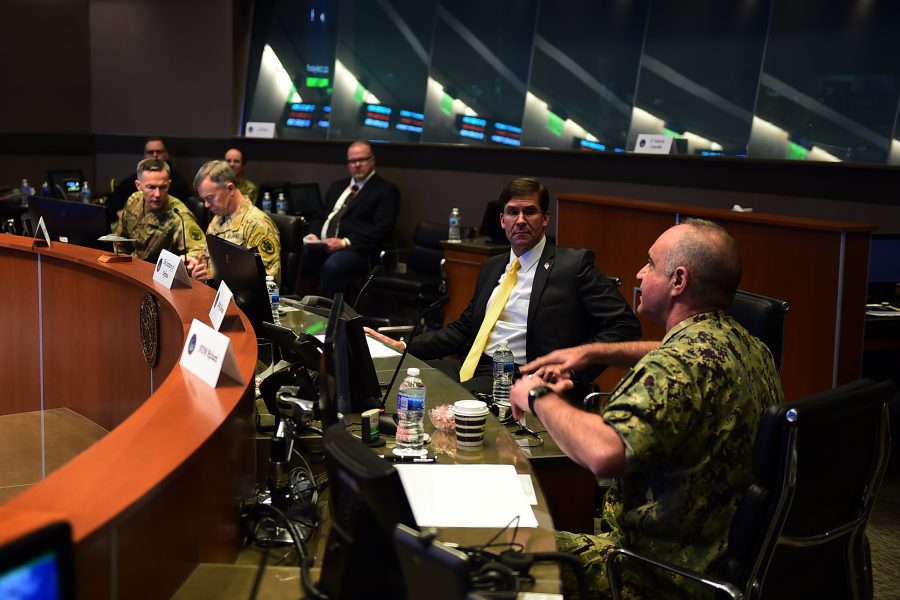Russia fires a nuclear weapon at a U.S. installation overseas. The U.S. retaliates in kind. How does it all play out?
U.S. Strategic Command simulated that scenario for Defense Secretary Mark Esper during a visit this week to Offutt Air Force Base, Neb. The exercise is part of the Pentagon’s routine slate of wargames and other events that it uses to consider its steps if nuclear war erupts, and comes as the U.S. is pursuing so-called “tactical” nuclear weapons to counter similar assets in Russia’s stockpile.
The idea of a tactical nuke is that, because they could do less damage than a larger weapon, a military might see them as a useful tool for regular battlefield operations.
The exercise featured a pretend Defense Secretary and a President facing a situation where Russia dropped a low-yield nuclear weapon on “a site on NATO territory” in wartime, a senior defense official told reporters Feb. 21. The United States hit back in a “limited response” using another nuclear weapon.
“You go through the conversation that you would have with the Secretary of Defense and then with the President, ultimately, to decide how to respond,” the official said. “They played out that game, and [Esper] got a good understanding for how that went.”
Rep. Jeff Fortenberry (R-Neb.) sat in on the gathering to learn more about the process as well, the official said.
Esper also visited nuclear missile and bomber crews at Minot Air Force Base, N.D., as part of the deterrence- and modernization-focused trip.
The Pentagon and other players in the defense world often ponder the question of how nuclear conflict might unfold if Russia attacked Europe. A recent Slate article noted that, in a different scenario, Obama-era National Security Council members looked at how the U.S. might react if Russia invaded a Baltic state and fired a low-yield nuke at NATO troops or at a base in Germany.
“The principals decided we had to respond with nuclear weapons, to maintain credibility among our allies and adversaries,” according to Slate. “They decided to fire a few nuclear weapons at the former Soviet republic of Belarus, even though, in the game, it had no involvement in the Russian attacks—and then they ended the game, without playing the next few steps.”
The defense official told reporters that STRATCOM and the Joint Staff also practice going through the motions of what to do during a nuclear crisis, like holding a conference to decide whether a missile launch poses a threat to the U.S.
“If there is a required response, a nuclear response, again, they exercise that, and they get different people to play—exercise secretary, exercise president, so they’re familiar with the mechanical process of making these decisions and providing the orders back out to the fleet,” the official said.
A Pentagon spokesman said it is routine for military officials to exercise all possible scenarios.
The U.S. is pursuing the W76-2 warhead for its submarine-launched ballistic missile as its own tactical nuclear weapon in response to Russian development. The defense official called the W76-2 the “least expensive, quickest way that we could put something in the field to show Russia that we have the capability in addition to the resolve to address any threat that they could pose to us.”
Undersecretary of Defense for Policy John Rood confirmed Feb. 4 the Navy has deployed the new warhead on a submarine, though the Defense Department says it is stopping short of bringing additional nuclear weapons to the European continent.
“We have no intention to field a new low-yield system in Europe,” the defense official added. “Our response to the Russian violation [of the 1987 Intermediate-Range Nuclear Forces Treaty] is a conventional response. We’ll respond with conventional cruise missiles and conventional ballistic missiles of the range that’s captured by the INF Treaty, but we have no intention to make it nuclear-capable, nor have we actually spoken to the allies about basing it on their territory at this time.”
DOD is developing other nuclear weapons to counter foreign stockpiles as well, including ground- and sea-launched cruise missiles. The INF Treaty banned deployment of ground-based ballistic and cruise missiles, nuclear or conventional, built to strike targets between 500 and 5,500 kilometers away. The U.S. left the treaty last August in protest that Russia was flouting the pact.
Esper told reporters Feb. 19 he believes the Russians should count both strategic and non-strategic nuclear weapons under a renegotiated version of the New START Treaty, which dictates stockpile sizes and expires next year.
